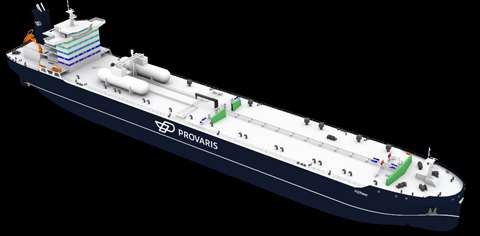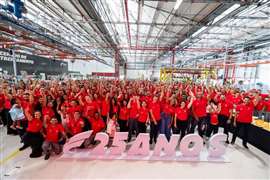Compressed hydrogen carrier wins approval
13 December 2022
Provaris calls step “key” to unlocking hydrogen shipping
 Illustration of the H2Neo 26 000 m3 compressed H2 carrier. (Image: Provaris)
Illustration of the H2Neo 26 000 m3 compressed H2 carrier. (Image: Provaris)
Provaris Energy, a developer of integrated compressed hydrogen projects, has received design approval for a 26 000 m3 compressed hydrogen carrier from the American Bureau of Shipping (ABS).
According to the company, the milestone approval follows the completion of extensive Front End Engineering Design (FEED) work and ABS review activities, which confirms that the company’s multi-layered hydrogen tank can be incorporated into the H2Neo carrier and meet the requirements for Ship Classification. The company said it would construct and test a prototype hydrogen tank and prepare for ship construction.
“Through our close collaboration with ABS throughout this three-year process, we are confident that our compressed hydrogen carriers can safely and effectively establish the maritime transportation of hydrogen at a time when storage and transport remain key to unlocking markets with ambitions for hydrogen imports at scale from 2026,” said Per Roed, chief technical executive officer at Provaris.
In October 2020, Provaris launched its program to develop a compressed hydrogen carrier and in 2021 ABS awarded Porvaris with an Approval in Principle (AiP) for two classes of green compressed hydrogen carriers, the H2Neo (26 000m3) and the H2Max (120 000 m3). Provaris said it is taking the H2Neo through to construction-ready status in 2023 with the H2Max to follow in 2026.
Provaris spent 12 months completing this extensive FEED level design package for the H2Neo. This work program has been delivered on time and on budget, which has culminated in the receipt of a Design Approval from ABS, that confirms:
- The ship design is verified as capable of transporting compressed hydrogen at bulk scale at 250 bar pressure;
- The FEED package is sufficient for shipbuilders to quote (price and schedule) with confidence; and
- Critical safety studies, process and risk analyses have been carried out, which allowed ABS to verify relevant safety aspects of the ship’s design and operation.
Together with the receipt of ABS Design Approval for the H2Neo, Provaris is appointed Clarksons’ newbuild team in London to work with Provaris to undertake a shipyard selection and tender process as we move towards the order of a fleet of H2Neo carriers.
“ABS recognizes the potential that hydrogen shows in supporting a sustainable, lower carbon future,” said ABS’ Senior Vice President - Global Engineering and Technology, Patrick Ryan. “Safe and efficient storage and transportation of hydrogen at sea will be critical to the development and viability of the global hydrogen value chain. We have been working closely with Provaris, initially granting AIP in 2021 and subsequently reviewing their comprehensive FEED level package for the H2Neo. ABS is pleased to award Provaris approval of their design, and we look forward to continuing this relationship into continued testing and construction stages of H2Neo carriers, including a yard selection process, and to support Provaris during ship operations on the numerous, interesting projects on the H2 horizon.”
The H2Neo design is characterized by two large-diameter cylindrical tanks, one in each of the port and starboard cargo holds with a maximum allowable operating pressure (MAOP) of 250 bar. To avoid boil-off / cargo losses and to avoid the need for insulation and energy-intensive cooling during the voyage, the hydrogen is carried at ambient conditions. At these conditions, the design pressure rating of the cargo containment system has been determined to be 250 bar.
The advantage of the patented design, and Provaris’ Intellectual Property, is evident in the ABS-approved solution of integrating a relatively thick steel layered tank (as required for 250 bar) into the hull of a relatively conventional ship-sized hull with low operating drafts. Leveraging its experience with gas and compression, Provaris has assessed various compressed cargo containment solution options, duly taking into account the characteristics of hydrogen, including MAOP and temperature levels, and hydrogen embrittlement. These key parameters were considered in detail concerning safety, construction methodology / CAPEX and operations / OPEX.
The tanks are designed so that they cannot suddenly rupture and release a catastrophic amount of energy. This is achieved by a cargo tank construction that is composed of layers of steel, nested together, including a stainless-steel inner layer to protect the high-strength carbon steel from hydrogen embrittlement. This nesting ensures that sudden through-wall cracks are impossible.
Moreover, the layered tank construction benefits the construction methodology of the cargo tanks. Additional safety measures are applied through continuous monitoring of the cargo tanks integrity. By using components and software that are proven, and readily available, in the market, Provaris has developed a monitoring system that will be installed on the outermost layer of the cargo tanks. Compressed H2 to provide first mover advantage for regional trade of hydrogen Compression provides a simple and energy-efficient supply chain for green hydrogen. To facilitate maritime storage and transportation of compressed hydrogen, Provaris has developed the H2Neo and H2Max designs with a proprietary connecting the world to a clean energy future.
The loading of compressed hydrogen directly into the GH2 Carriers can be accomplished through existing, proven technology (compressors) eliminating the need for onshore hydrogen storage and/or facilities to convert the hydrogen into alternative forms at the loading port such as ammonia or liquefied H2. Similarly, the hydrogen will be delivered to customers directly through simple decompression from the ship’s cargo tanks, largely utilizing the energy stored in the cargo tanks, and there will be no need for facilities at the receiving terminal to store and/or crack, change, or regas the cargo before distribution.
POWER SOURCING GUIDE
The trusted reference and buyer’s guide for 83 years
The original “desktop search engine,” guiding nearly 10,000 users in more than 90 countries it is the primary reference for specifications and details on all the components that go into engine systems.
Visit Now
STAY CONNECTED




Receive the information you need when you need it through our world-leading magazines, newsletters and daily briefings.
CONNECT WITH THE TEAM













